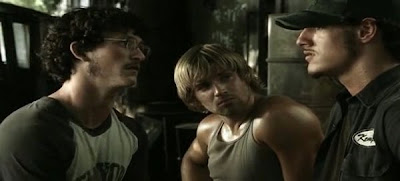Overall we have created a strong publicity campaign, encompassing are main product and our ancillary texts. The main aim for all of this is to get people into the cinema to watch our film and I think that our publicity campaign would just that. Here i will go over how i think each part of our publicity campaign would draw in an audience and then talk about the way we would introduce it starting with the poster, designed by me.
Movie Poster
we would start the campaign off by simply releasing the poster, this would subtly create hype. this is due to the fact that no-one will know exactly what it is at first, the only thing that will be shown in the poster is the tagline: "Daddys Little Girl", the main picture and the general colour scheme and feel of the whole campaign, the deep reds and powerful onyx black. This will generate interest amongst the hardcore fans but will slowly spread through the internet, we will pout posters up around in cinemas, and then eventually it will spread into more mainstream places like billboards, and wall adverts in shopping centres. Also word of mouth will be a huge means of propagating for us, due to the fact the poster is such an enigma, and is quite different to most, people will discuss its meaning. Then after is has gestated in the minds of the public will then release the teaser trailer.
Teaser Trailer
The trailer will first be released on the internet, through trailer and movie sites such as
apple trailers and
rotten tomatoes , this will cause a stir on the internet, which by the way will be another version of word of mouth, just a much larger global one. People will write articles about it, and social networking sites will be awash with people linking to the new trailer. Then after this it will be released in theatres, since the trailer has no violence and is suitable for people of any age, we will reach a very large audience.
Magazine Front Cover
Then finally as the hype steepens and the interest grows we will release the magazine dedication, we are using fright magazine due to its very large readership. This will finally give all the people who were interested in the trailer and poster a greater insight into what the film is really about.
Through all these three products i feel that we could cultivate a huge audience even before anyone has ever seen the film, simply due to interest in these, this means that many people will come to the cinema and see our film. I believe we have done quite a professional job in terms of creating a fully realised publicity campaign






































